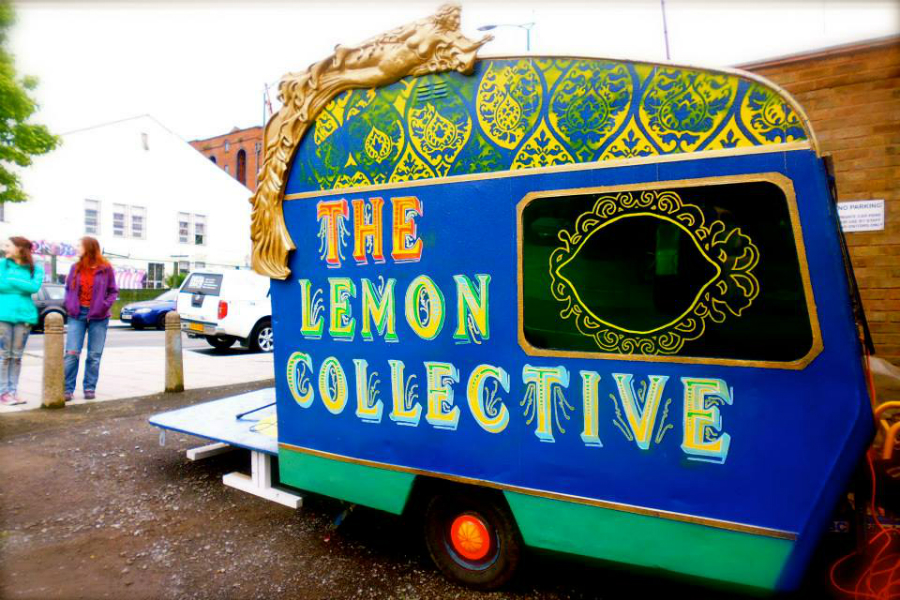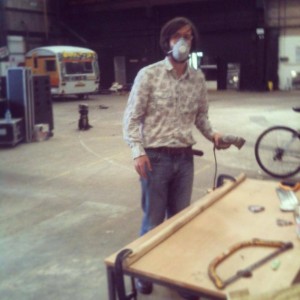Why We Need Grassroots Art: My Experience With The Lemon Collective
 Chris Carr defends and promotes the grassroots arts movement in Liverpool, under the threat of increasing urban redevelopment and commerce…
Chris Carr defends and promotes the grassroots arts movement in Liverpool, under the threat of increasing urban redevelopment and commerce…
Liverpool is a city that has, for a long time, been in the throes of an internal struggle between art and commerce. It is a city that quite rightly prides itself on its cultural heritage. But are there some in the city that would rather use that heritage merely as a gimmick in order to garner tourism revenue? It seems that there is, and has been, an ongoing argument between the creative minds that keep this city vibrant and the councillors whose interests are in profit margins.
I am part of a community of creative people called The Lemon Collective (TLC). Some of us are Liverpool John Moores Fine Art graduates, some of us belong to other art studios in the city. Since our inception in 2012, we have specialised in creating events that promote grassroots, DIY art. We have worked with performers, scientists, comedians, artists, musicians and writers; this month we took our renovated Lemon Caravan to support the Liverpool Flyover Festival; a few weeks before that we helped launch the first Baltic Triangle street art festival, Markit, with poets Olly Leigh, Rebecca Brookfield and Laurence Glover performing.
Housed in this great area (on Hurst Street), we also recently became the lucky custodians of a warehouse called The Glass Factory. It’s a space that dwarfs every one of us, but we’ve managed to use it productively, getting our hands dirty clearing the factory floor and filling it with art in many different forms. So far, we’ve transformed a small area of the warehouse into a venue space; Greenbrick Graphics company have installed themselves (and a green screen); and we recently hosted the LJMU MA Fine Art exhibition The Needle’s Eye. So yeah, it’s been a busy summer.
While all this has been developing, it’s been interesting to observe the gap that exists between the Baltic Triangle area and the city centre. The Baltic Triangle boasts a great, working creative community and is a magnet for creative and digital businesses based in and around studios Elevator and Baltic Creative. Some of the many burgeoning organisations that have taken root in this area include print collectives Hello Jonzo and The Critter Shed, ceramic and textiles specialist Alison Appleton, the creative education and promotion company As Creatives, as well as the more obvious (and very busy) venues such as Camp and Furnace, Unit 51, Baltic Bakehouse and Constellations. A rare example of working regeneration, as VICE recently reported.
Once you cross the traffic lights, however, and enter Liverpool One, there is a completely different atmosphere from the one that exists within the confines of the Baltic. It’s all commerce. All shopping bargains and heavy ad campaigns. Evidently the gap that exists between the Baltic Triangle and the city centre is not just a question of distance, but also a question of culture. It’s fantastic to have a specific creative site, don’t get me wrong; but is this at the expense of actually removing small acts of creativity from L1? It seems to me that Liverpool has moved its creative hub out of the city centre, sweeping it under the proverbial rug and into the Baltic Triangle, in a strategic effort to make more room for commerce.

Outside of London, Liverpool has the fastest growing economy in Britain, which certainly looks good on paper. In times of recession it is a boon to the city’s inhabitants, not to mention to its reputation, to have a growing economy. This gives the illusion of security and stability, and, as I said, it looks good on paper. But what cultural cost has this growth taken? This is the same city that was named European Capital of Culture in 2008 and yet any hint of cultural movement within the main hub of the city centre is now practically void. Working creative community spaces do still exist in the central areas, such as the Bluecoat and Mello Mello (which is soon to move), but all emphasis is placed on retail outlets.
I must stress that I have a strong love for the Baltic Triangle and all that it contains. I am not bemoaning its existence or development one iota. It just seems awfully convenient, to me, that not so many years after Liverpool One opened its glossy doors, investors have targeted innumerable sites to build more commercial spaces (shops, car parks, student flats) in the city centre, and the once colourful capital of culture has now turned a mottled beige; innocuous and featureless. At the same time, those factions that rendered Liverpool’s vibrancy and colour have now been huddled within the Baltic Triangle; conveniently at a distance from the centre of the city.
As a result, we Baltic-dwellers are starting to build a strong community. The Glass Factory has become testament to the sheer diversity of artists that live and work here; in amongst TLC’s ranks we have painters, illustrators, puppeteers, sculptors, and writers. Since the start of our warehouse adventure, we have had the privilege of collaborating with people who bring life and joy into the public realm: Szymon Mamys and his fire dancing troupe Bring The Fire Project, music group The Sample-ist, rhythm group Echo Heartbeat Community. All in our warehouse, tucked away into the folds of an old industrial area of Liverpool.
We need places like The Glass Factory. We are one of many collectives and organisations that are developing a progressive DIY culture within that area. The Glass Factory, and places like it, are spaces where all of these different minds can converge and collaborate. They’re proof that Liverpool is indeed a city with an unrelenting creative momentum. They’re also proof that, no matter whether or not Liverpool champions its artists or sells their spaces, there is a grassroots creative culture in this city that will not lie down.
If there is one great thing about the migration of the city’s creative energy into the Baltic Triangle, it is that this area has now become a centre of serious development for creative entrepreneurs big and small. We are all seeing an energetic movement of people, events, projects and businesses flowing through this zone, and this, again, reflects on the persistent nature of the people that work there. Things happening in The Glass Factory are a small but important part of its grassroots movement — a hub for creative minds, I’m proud to say, and I continue to be surprised by the wealth of ideas that are expressed within it’s tall and cavernous walls.
If the Baltic Triangle is indeed to become Liverpool’s official hub for creativity, it is something that we should all do our utmost to nurture. It’s a reflection of the city, its people and its spirit, where big ideas take root and grow.
Chris Carr
Find out more about The Lemon Collective and The Glass Factory on their website and on Twitter @LemonCollective
Read more about the creative industries being the fastest growing economy in the UK here





